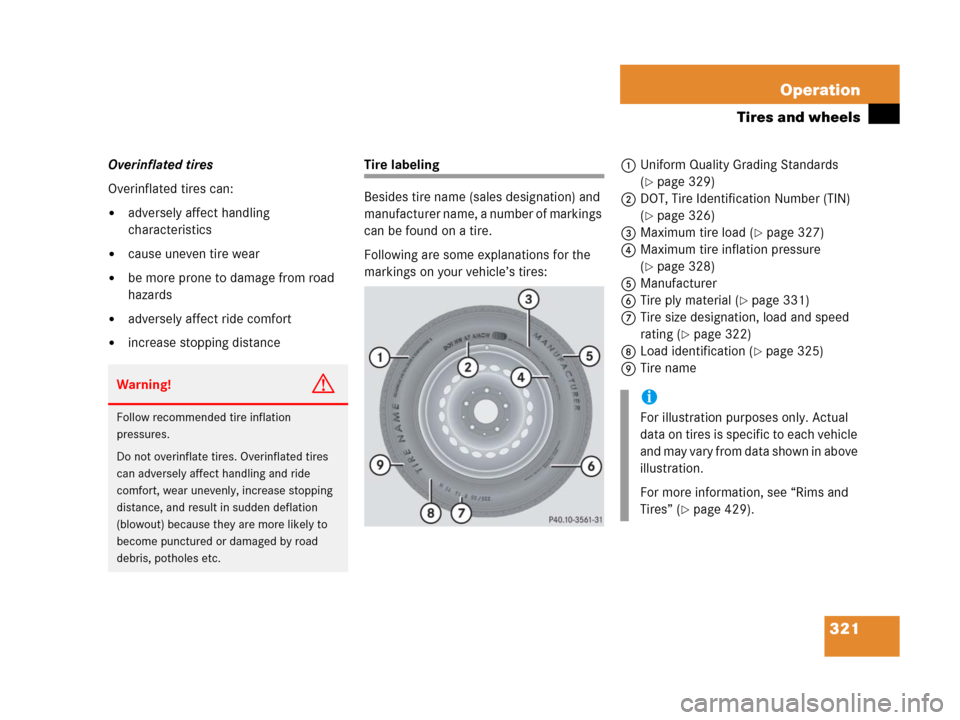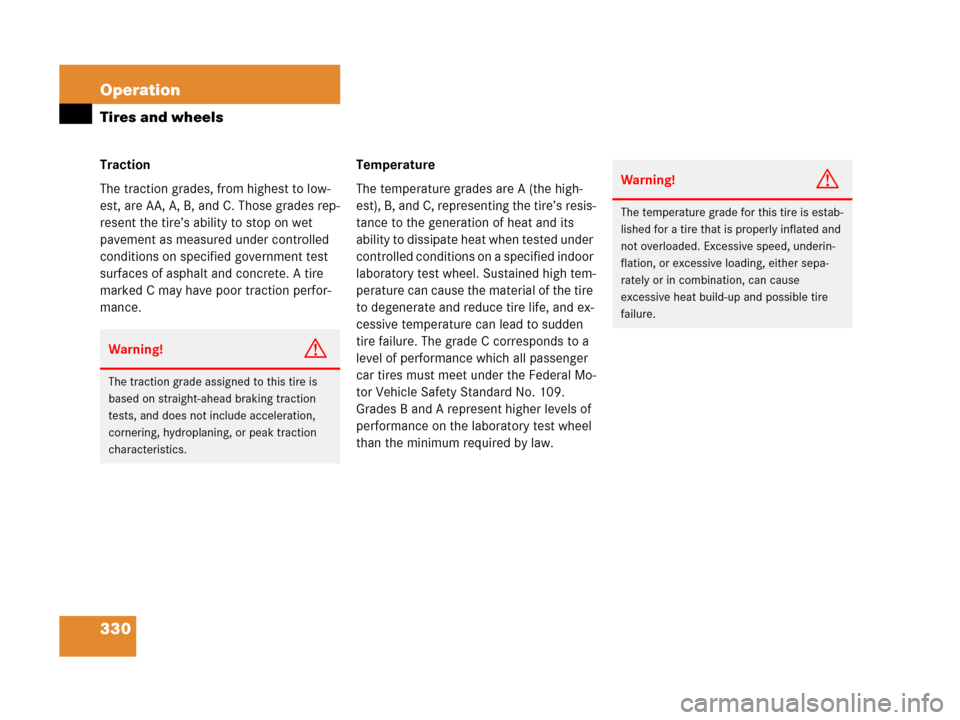Page 321 of 473

320 Operation
Tires and wheels
�Switch on the ignition (�page 33).
The standard display menu appears in
the multifunction display (
�page 130).
�Press buttonk orj repeatedly
until the following message appears in
the multifunction display:
Run Flat Indicator
active
Reactivation possible: +
�Press buttonæ.
The following message will appear in
the multifunction display:
Tire pres. OK now?
If you wish to confirm activation:
�Press buttonæ.
The following message will appear in
the multifunction display:
Run Flat Indicator
Reactivated
After a certain “learning phase”, the Run
Flat Indicator checks the set pressure
values for all four tires.
If you wish to cancel activation:
�Press buttonç.
or
�Wait until the message
Tire pres. OK now?
disappears.Potential problems associated with
underinflated and overinflated tires
Underinflated tires
Underinflated tires can:
�cause excessive and uneven tire wear
�adversely affect fuel economy
�lead to tire failure from being
overheated
�adversely affect handling
characteristics
Warning!G
The Run Flat Indicator* can only warn you in
a reliable manner if you have set the correct
tire inflation pressures for each tire.
If an incorrect tire inflation pressure was
set, the system will monitor the pressure
according to the incorrect value.
Warning!G
Follow recommended tire inflation pres-
sures.
Do not underinflate tires. Underinflated tires
wear excessively and / or unevenly,
adversely affect handling and fuel economy,
and are more likely to fail from being
overheated.
Page 322 of 473

321 Operation
Tires and wheels
Overinflated tires
Overinflated tires can:
�adversely affect handling
characteristics
�cause uneven tire wear
�be more prone to damage from road
hazards
�adversely affect ride comfort
�increase stopping distance
Tire labeling
Besides tire name (sales designation) and
manufacturer name, a number of markings
can be found on a tire.
Following are some explanations for the
markings on your vehicle’s tires:1Uniform Quality Grading Standards
(
�page 329)
2DOT, Tire Identification Number (TIN)
(
�page 326)
3Maximum tire load (
�page 327)
4Maximum tire inflation pressure
(
�page 328)
5Manufacturer
6Tire ply material (
�page 331)
7Tire size designation, load and speed
rating (
�page 322)
8Load identification (
�page 325)
9Tire name
Warning!G
Follow recommended tire inflation
pressures.
Do not overinflate tires. Overinflated tires
can adversely affect handling and ride
comfort, wear unevenly, increase stopping
distance, and result in sudden deflation
(blowout) because they are more likely to
become punctured or damaged by road
debris, potholes etc.
i
For illustration purposes only. Actual
data on tires is specific to each vehicle
and may vary from data shown in above
illustration.
For more information, see “Rims and
Tires” (
�page 429).
Page 329 of 473

328 Operation
Tires and wheels
For more information on tire load rating
(
�page 323).
For information on calculating total and
cargo load capacities (
�page 311).
Maximum tire inflation pressure
1Maximum permissible tire inflation
pressure
This is the maximum permissible tire
inflation pressure for the tire.Always follow the recommended tire
inflation pressure (
�page 315) for proper
tire inflation. Warning!G
Do not overload the tires by exceeding the
specified load limit or vehicle capacity
weight as indicated on the placard located
on the driver’s door B-pillar. Overloading the
tires can overheat them, possibly causing a
blowout. Overloading the tires can also
result in handling or steering problems, or
brake failure.
i
For illustration purposes only. Actual
data on tires is specific to each vehicle
and may vary from data shown in above
illustration.
Warning!G
Never exceed the max. tire inflation
pressure. Follow recommended tire inflation
pressures.
Do not underinflate tires. Underinflated tires
wear excessively and / or unevenly, adverse-
ly affect handling and fuel economy, and are
more likely to fail from being overheated.
Do not overinflate tires. Overinflated tires
can adversely affect handling and ride com-
fort, wear unevenly, increase stopping dis-
tance, and result in sudden deflation
(blowout) because they are more likely to
become punctured or damaged by road de-
bris, potholes etc.
Page 331 of 473

330 Operation
Tires and wheels
Traction
The traction grades, from highest to low-
est, are AA, A, B, and C. Those grades rep-
resent the tire’s ability to stop on wet
pavement as measured under controlled
conditions on specified government test
surfaces of asphalt and concrete. A tire
marked C may have poor traction perfor-
mance.Temperature
The temperature grades are A (the high-
est), B, and C, representing the tire’s resis-
tance to the generation of heat and its
ability to dissipate heat when tested under
controlled conditions on a specified indoor
laboratory test wheel. Sustained high tem-
perature can cause the material of the tire
to degenerate and reduce tire life, and ex-
cessive temperature can lead to sudden
tire failure. The grade C corresponds to a
level of performance which all passenger
car tires must meet under the Federal Mo-
tor Vehicle Safety Standard No. 109.
Grades B and A represent higher levels of
performance on the laboratory test wheel
than the minimum required by law.
Warning!G
The traction grade assigned to this tire is
based on straight-ahead braking traction
tests, and does not include acceleration,
cornering, hydroplaning, or peak traction
characteristics.
Warning!G
The temperature grade for this tire is estab-
lished for a tire that is properly inflated and
not overloaded. Excessive speed, underin-
flation, or excessive loading, either sepa-
rately or in combination, can cause
excessive heat build-up and possible tire
failure.
Page 332 of 473

331 Operation
Tires and wheels
Tire ply material
1Plies in sidewall
2Plies under tread
This marking tells you about the type of
cord and number of plies in the sidewall
and under the tread.Tire and loading terminology
Accessory weight
The combined weight (in excess of those
standard items which may be replaced) of
automatic transmission, power steering,
power brakes, power windows, power
seats, radio, and heater, to the extent that
these items are available as
factory-installed equipment (whether
installed or not).
Air pressure
The amount of air inside the tire pressing
outward on each square inch of the tire.
Air pressure is expressed in pounds per
square inch (psi), or kilopascal (kPa) or
bar.Aspect ratio
Dimensional relationship between tire
section height and section width
expressed in percentage.
Bar
Another metric unit for air pressure. There
are 14.5038 pounds per square inch (psi)
to 1 bar; there are 100 kilopascal (kPa)
to 1 bar.
Bead
The tire bead contains steel wires wrapped
by steel cords that hold the tire onto the
rim.
Cold tire inflation pressure
Tire inflation pressure when your vehicle
has been sitting for at least three hours or
driven no more than one mile (1.6 km).
i
For illustration purposes only. Actual
data on tires is specific to each vehicle
and may vary from data shown in above
illustration.
Page 334 of 473

333 Operation
Tires and wheels
Maximum tire inflation pressure
This number is the greatest amount of air
pressure that should ever be put in the tire
under normal driving conditions.
Normal occupant weight
The number of occupants the vehicle is
designed to seat, multiplied by
68 kilograms (150 lbs).
Occupant distribution
The distribution of occupants in a vehicle
at their designated seating positions.Production options weight
The combined weight of those installed
regular production options weighing over
5 lbs (2.3 kilograms) in excess of those
standard items which they replace, not
previously considered in curb weight or
accessory weight, including heavy duty
brakes, ride levelers, roof rack, heavy duty
battery, and special trim.
PSI (P
ounds per square inch)
A standard unit of measure for air pressure
-> bar, kilopascal (kPa).
Recommended tire inflation pressure
Recommended tire inflation pressure
listed on placard located on driver’s door
B-pillar for normal driving conditions.
Provides best handling, tread life and
riding comfort.Rim
A metal support for a tire or a tire and tube
assembly upon which the tire beads are
seated.
Sidewall
The portion of a tire between the tread and
the bead.
TIN (Tire Identification Number)
Unique identifier which facilitates efforts
by tire manufacturers to notify purchasers
in recall situations or other safety matters
concerning tires and gives purchases the
means to easily identify such tires. The TIN
is comprised of “Manufacturer’s identifica-
tion mark”, “Tire size”, “Tire type code”
and “Date of manufacture”.
Page 336 of 473

335 Operation
Tires and wheels
Rotating tires
Tire rotation can be performed on vehicles
with tires of the same dimension all
around. If your vehicle is equipped with
tires of the same dimension all around,
tires can be rotated, observing a a
front-to-rear rotation pattern that will
maintain the intended rotation (spinning)
direction of the tire (
�page 308).
In some cases, such as when your vehicle
is equipped with mixed-size tires (different
tire dimension front vs. rear), tire rotation
is not possible.If applicable to your vehicle’s tire configu-
ration, tires can be rotated according to
the tire manufacturer’s recommended in-
tervals in the tire manufacturer’s warranty
pamphlet located in your vehicle literature
portfolio. If none is available, tires should
be rotated every 3 000 to 6 000 miles
(5 000 to 10 000 km), or sooner if neces-
sary, according to the degree of tire wear.
The same rotation (spinning) direction
must be maintained (
�page 308).
Rotate tires before the characteristic tire
wear pattern becomes visible (shoulder
wear on front tires and tread center wear
on rear tires).
Thoroughly clean the mounting face of
wheels and brake disks, i.e. the inner side
of the wheels/tires, during each rotation.
Check for and ensure proper tire inflation
pressure.For information on wheel change, see the
“Practical hints” section (
�page 380) and
(
�page 404).
Warning!G
Rotate front and rear wheels only if the tires
are of the same dimension.
If your vehicle is equipped with mixed-size
tires (different tire dimensions front vs.
rear), tire rotation is not possible.
Warning!G
Have the tightening torque checked after
changing a wheel. Wheels could become
loose if not tightened with a torque of
80 lb-ft (110 Nm).
Only use genuine Mercedes-Benz wheel
bolts specified for your vehicle’s rims.
Page 350 of 473
349 Practical hints
What to do if …
Where will I find ...?
Unlocking/locking in an emergency
Opening/closing in an emergency
Resetting activated head restraints
Replacing SmartKey batteries
Replacing bulbs
Replacing wiper blades
Flat tire
Battery
Jump starting
Towing the vehicle
Fuses